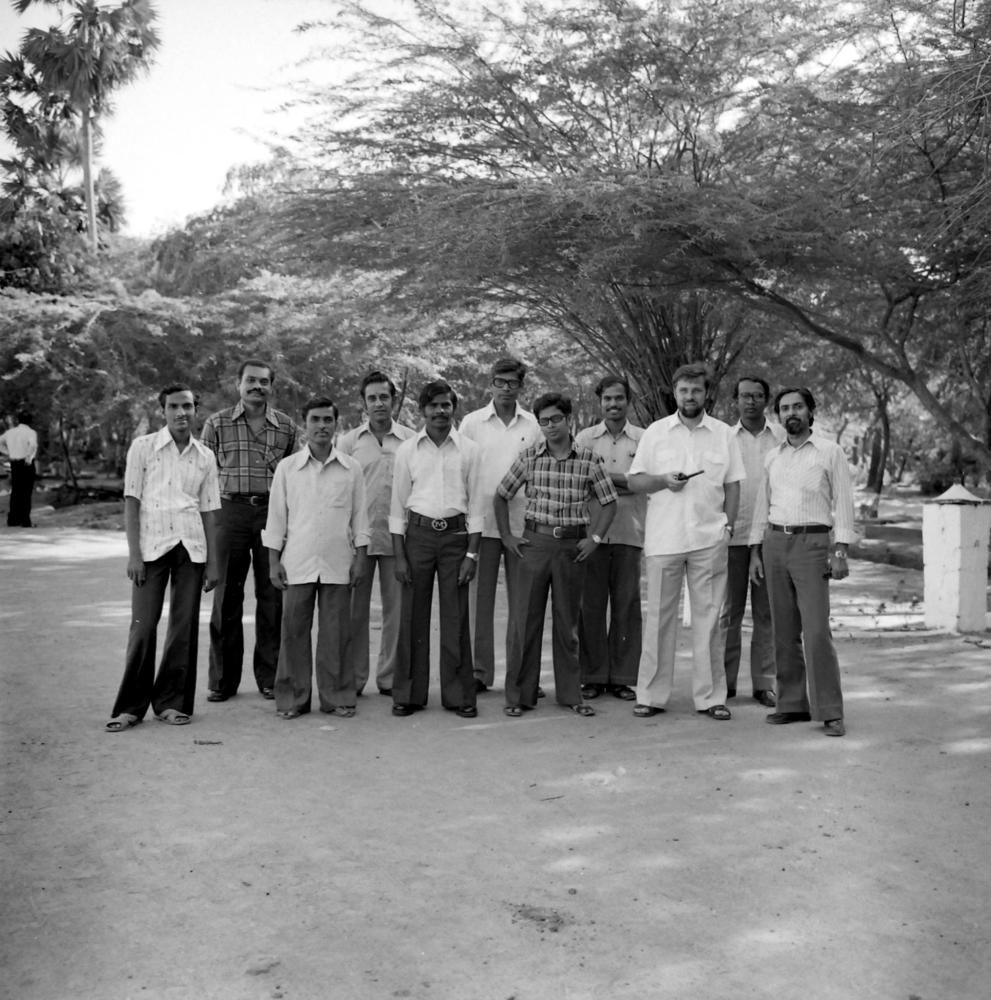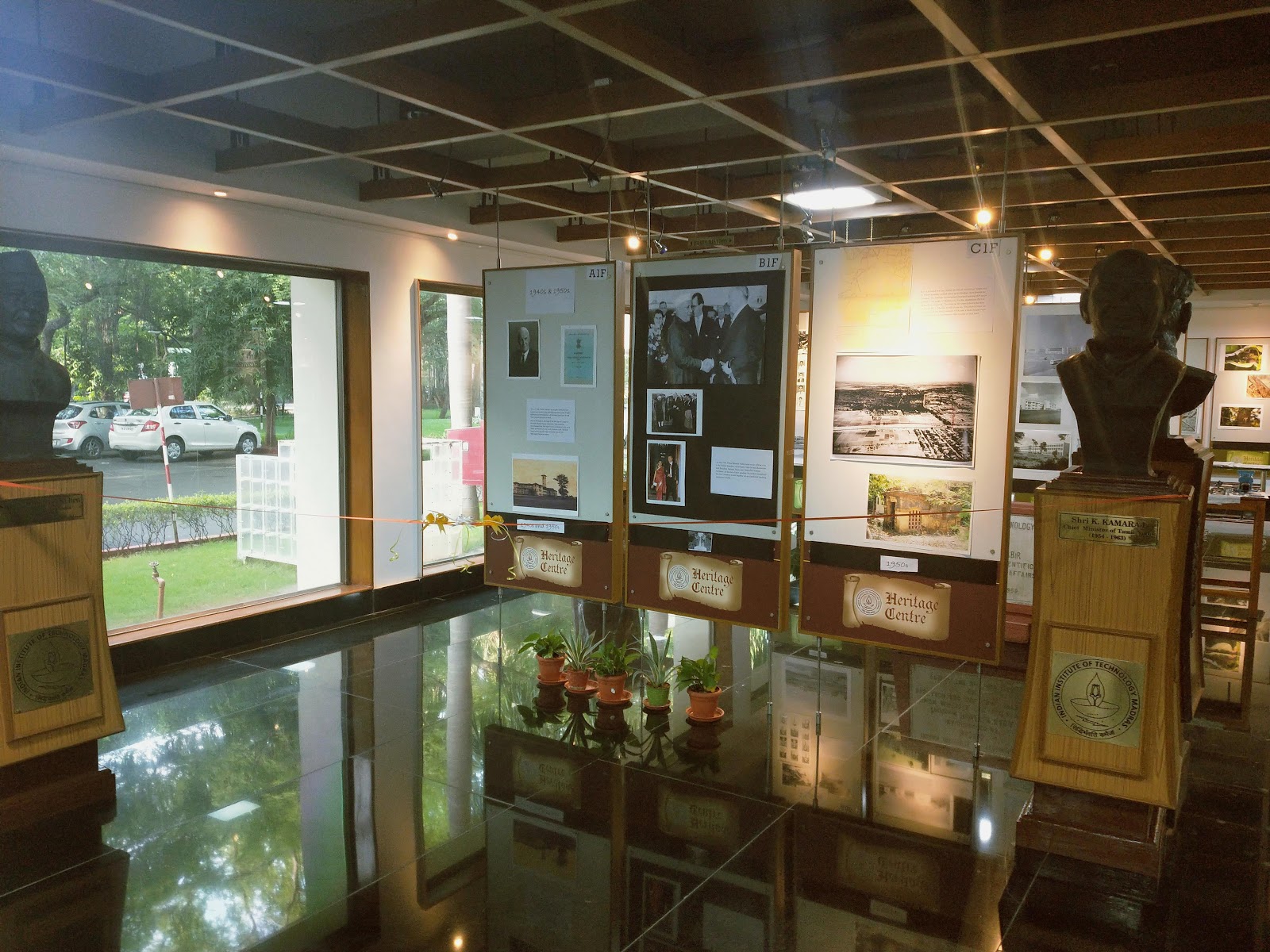More than half a century ago, Fresher alighted at Central Station, half dazed. The train ride had been dreadful, just dreadful. The Sun bore down malevolently from high up above, and he stood there – trunks aloft – as he melted in its heat. Right when he thought he’d swoon like a fairy-tale damsel – with considerably less grace, of course – a kind stranger asked him to board No. 19, which he did. A while later, when he got off at Sardar Patel Road, Fresher glimpsed a big black gate from afar, and that’s when he finally knew where he was.
He shuffled past the gates under the watchful gaze of a rather menacing security guard (whom we shall furnish with a handlebar moustache for creative reasons), trunks screeching along on the asphalt behind him. Much to his chagrin, his legs seemed to take him nowhere. Yes, there was a tarred road to take him wherever it is that he was going, but little else. Little else but for the swimming pool (which was fenced in, by the way) and the Building Sciences Block, that is. And Tapti, of course, where he took up lodgings during his first year at IIT Madras. So here’s the question: how did this (mostly) forest we call home grew and transformed over the years to become the rather vibrant community that it is now? How did we carve that perfect leg out of this gigantic Thanksgiving turkey? Hmm, I think I’ll have a go at it.
How It All Began
First of all, I must apologize for beginning our story with a slight detour. But now that we’ve seen what IIT Madras would have looked like if you were alive and well and enough of a smarty-pants to crawl in here back in 1964, and now that we’ve established that we are all happy to be here now and not then, tis rewind time.
Basics first. IIT Madras was the third IIT to be established in India. It had been the outcome of Pandit Nehru’s 1956 visit to West Germany, with the latter deciding to offer financial and technical assistance in setting up an institute. This institute would, unlike its predecessors in Kharagpur, Bombay and Kanpur, focus both on technical education and the humanities. Initial deliberations tried to assimilate the proposed institute into institutions already existing at that point in time, such as the Madras Institute of Technology and the Anantapur Engineering college. However, the Southern Regional Committee of the All India Council of Technical Education ditched that plan and bestowed IIT Madras with its own independent existence.
The Madras State Government, under the then Chief Minister K. Kamaraj, lavished it with prime real estate as well: 632 acres carved out of Guindy National Park, straddling Adyar and Velachery, and that too, in close proximity to Raj Bhavan.
This included about 300 acres of woodlands, another 100 acres comprising lakes and irrigation tanks and the rest belonging to Taramani village.
Those of us used to the way things are would find it fascinating to know that IIT Madras could just as easily have been IIT Bangalore. In fact, the Germans had zeroed in on Bangalore, but then Education minister of Tamil Nadu, C. Subramaniam, gave them a tour and voila! The Germans were rather enchanted by all the deer herds and banyan groves, it seems.
Early Years: The Campus Without a Campus

On 31st July, 1959, IITM was inaugurated, with the foundation stone originally being laid in the open space between the Central Leather Research Institute (CLRI) and Alagappa Chettiar College of Technology by Education minister Humayun Kabir.
Until July 1961, when the institute shifted to its own campus, classes proceeded close by, mostly at the Alagappa Chettiar College, where classrooms, laboratories, drawing-rooms, teachers’ rooms and the library were allocated for the time being.
Two large rooms at the CLRI served as IITM’s administrative offices. Workshops used to be conducted at the Highway Research Station nearby. Two rented hostels – the Saidapet Hostel and the Guindy Hostel – accommodated the inaugural B.Tech batch of 120. Fascinating accounts about how they had to ride down the Adyar river every morning to make it to class all the way from t Saidapet abound in the annals of IITM. Such attempts would be deemed heroic now, at least by the likes of me. Waking up at 7:45 for 8 am classes has become a thing. All jokes aside, what I find remarkable about the whole affair is the systematic way in which everyone involved engaged in a herculean coordinating effort between Germany, the Central Government, the State Government and the various individuals and institutions that help bring IIT Madras into being. In the interlude, while IITM lived off of such benevolence, we slowly began chiselling our way through Guindy National Park. The sixties was a frenetic time indeed. Roads and electric cables vivisected pristine vegetation. Fresher must have been rather taken aback by it all.
Dankeschön Deutschland

Meanwhile, buildings began coming up in the erstwhile ‘Deer Park’, thanks in large part to German assistance. With construction going into full swing, the library was given prime importance. After all, of what use is a college if there’s nothing to learn from (though I am pretty sure that wouldn’t bother a lot of us)? Even when the library was located within Alagappa Chettiar’s premises, IITM ordered books worth 80,000 rupees, which was quite a huge sum back then. In addition to this, Germany was generous enough to gift another thousand books to the budding collection. In August 1961, however, the library secured more comfortable quarters on the second floor of the first building to come up on campus – the Civil Engineering block, which used to be the Building Sciences block back then (The BSB also holds the distinction of hosting the first classroom in the campus – BSB 105).
This library was a truly indigenous creation, even in the sense that every piece of furniture that filled it came from the IITM workshops (which in turn, was a compulsory initiative propelled by the Germans – okay, maybe not completely indigenous).
However, as tangible as the pride was, the library felt out of place here too. It found a place of its own, in a brand-new building in 1967, where it remained for the next thirty-three years, after which it shifted to our present Central Library structure. The old building subsequently began housing the Department of Management Studies (DoMS).
The Growth Spurt Years

The institute itself was initially envisioned for a paltry 2000 people, which seems minuscule in retrospect. The Board of Directors decided to establish ten departments – Civil Engineering, Mechanical Engineering, Electrical Engineering, Chemical Engineering, Metallurgy, Physics, Chemistry, Applied Mechanics and Humanities. An Aeronautics department, which was not included in the original plan, also rose. Our first Director, Professor Sengupto, spearheaded this process with admirable vigour. The sixties saw IITM sprawling out over forest land. In fact, most of our landmarks are a product of these whirlwind years, be it the Taramani Guesthouse (then known as the Officers Hostel), the Bose-Einstein Guesthouse (then the Institute Guesthouse), Gajendra Circle, Admin Block, OAT, the current DoMS building, the Central Workshop, the Gymkhana, the Institute Stadium, Sangam Skating Rink and many more.
Soon after the first year had flown by, the Cauvery and Krishna hostels were built, and the men claimed dominion over (at least mostly) 600-plus acres until the women made their grand appearance back in ’68, when Sarayu rose up.
Hostel Scenes Wonly

The second batch inducted into IIT Madras was the first to reside on campus, in the Krishna hostel. Not long after, the inaugural batch moved into Cauvery. Till the eighties came a-calling, an ancient power socket and a provision for a single lamp were the sole homages to electricity. They used to have separate vegetarian and non-vegetarian kitchens within the hostel itself, instead of the ‘super’-messes that we see now, but our scholars did not appear to be too happy with them, so much so that sarcastic quips such as these were a common sight in student-run newspapers: ‘For Sale: Unused chapattis from Kaveri, Krishna and Narmada hostels. Leather dealers please note.’ (read this article for details!). These two hostels were unique with regard to their open layout, whereas hostels that popped up later on, beginning with Tapti in 1963 had 64-rooms-per-floor-by-three-floors, with a quadrangle contained within.
Built in the early seventies, Brahmaputra became the gold standard for boys’ hostels, boasting rooms with ceiling fans.
The rest of the plebs had to do with table fans they brought from home. A single power socket would mean that if you had an exam tomorrow, and your roommate happened to be an early-to-bed-early-to-rise type of fellow, it was a question of table lamp (if you had the money to get one) versus table fan. One can only hope that the occasional power cuts levelled the playing field, which they did apparently (Oh, the irony of studying for a Transmission and Distribution examination by candlelight…)
Talking about playing fields… When the nation’s best young scientific luminaries were not busy studying, they took to the hostel grounds to cool down over a game of volleyball or tennikoit or gathered around that solitary black-and-white television ever since the telly made its way into the Krishna common room back in 1976.
All the Feels
With time, many traditions and cultures flourished on our tiny nook of green, be it Saturday movies at OAT or Hostel Nights where one could experience a medley of Indian and Germanic singing, the curious phenomenon of sober regionalism, a restaurant dining culture (starting with the now extinct Knick-Knack in the seventies), late night walks, skipping breakfasts, two-minute baths, starlit naps on the Himalaya lawns, selfies with the deer and blackbucks, a going-to-Phoenix culture, a going-to-Pondi culture, a going-to-Mahabs culture…
To reduce IIT Madras to merely rick-and-mortar would be a disservice to its legacy. Have you ever wondered about the identity of your room’s mystery inhabitants over the years, before you came into its possession? What did they look like? Were they moody little things or were they too happy for this world? Did they have friends? Were they alone? Where did they go on Sundays? What did they like to eat? Our little nook of green, it seems, is not so little after all. If you sit down and think about it, we are a part of an overwhelming legacy spanning six decades. It is up to us to carry it forward and tell our stories now.
Image and archival credits: IIT Madras Heritage Centre
(G)olden Tickets is a heritage series in celebration of 60 years of IIT Madras and coincidentally, 10 years of The Fifth Estate. We comb through archives in the Heritage Centre, interview alumni, and dig up little known insti trivia to travel back in time. Join us on this journey with (G)olden Tickets. Comments and suggestions are always welcome, you can send them to us at [email protected].
Series by Sharayu Shejale





IIT Madras , I knew the campus and life there since 1965 , lived in hostels Krishna, Kaveri, Alakananda as a research scholar or as Assistant Warden and quarter H ,E,D,C,B types. with my family.
I always felt a cooperative, conducive family atmosphere all the time inside the campus. Two of my children were born in the Institute Hospital and all my children were brought up inside the campus, studied in the campus schools.
After my retirement (2002) when we moved to outside we surely missed the campus life.